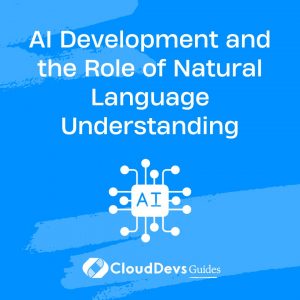AI & Natural Language Understanding
In today’s rapidly evolving technological landscape, Artificial Intelligence (AI) has emerged as a transformative force with applications spanning across industries. At the heart of this AI revolution lies Natural Language Understanding (NLU), a crucial component that enables machines to comprehend and interact with human language. This blog delves into the realm of AI development, shedding light on the pivotal role of Natural Language Understanding, its significance, benefits, and provides insightful code examples to illustrate its implementation.
1. Understanding Artificial Intelligence (AI) Development
Artificial Intelligence refers to the simulation of human intelligence processes by machines, especially computer systems. It involves the development of algorithms and models that enable computers to perform tasks that typically require human intelligence. These tasks encompass a wide spectrum, including problem-solving, decision-making, speech recognition, visual perception, and language comprehension. AI development is fueled by various techniques, including machine learning, neural networks, and deep learning.
2. The Evolution of Natural Language Understanding (NLU)
Among the myriad of AI applications, Natural Language Understanding holds a special place. NLU is a subset of Natural Language Processing (NLP), which focuses on enabling computers to understand, interpret, and generate human language. NLU takes this a step further by allowing machines to comprehend the nuances, context, and intent behind human communication. The evolution of NLU has been marked by remarkable advancements, thanks to the integration of deep learning techniques and the availability of vast datasets.
3. The Significance of Natural Language Understanding in AI Development
The integration of Natural Language Understanding in AI development has far-reaching implications across industries and domains:
3.1. Enhanced User Interaction:
NLU enables machines to understand user inputs in natural language, leading to more intuitive and user-friendly interactions. Virtual assistants, chatbots, and voice assistants leverage NLU to provide personalized and contextually relevant responses to user queries.
3.2. Insight Extraction:
NLU techniques empower machines to extract insights from unstructured text data, such as social media posts, customer reviews, and news articles. This aids businesses in understanding customer sentiments, market trends, and competitor analysis.
3.3. Language Translation:
NLU plays a pivotal role in language translation applications. Machine translation models, like Google Translate, utilize NLU to decipher the meaning behind sentences in one language and generate coherent translations in another.
3.4. Content Generation:
Content creation can be optimized using NLU-powered tools that generate human-like text based on prompts. These tools find applications in creating marketing copies, product descriptions, and even news articles.
3.5. Data Analysis:
NLU-driven data analysis allows organizations to process and analyze large volumes of textual data, enabling them to make data-driven decisions and uncover valuable insights.
4. Implementing Natural Language Understanding: Code Examples
Let’s explore some code examples to understand how Natural Language Understanding can be implemented using popular libraries and frameworks:
4.1. Text Classification with Python and scikit-learn:
python
from sklearn.feature_extraction.text import TfidfVectorizer
from sklearn.model_selection import train_test_split
from sklearn.naive_bayes import MultinomialNB
from sklearn.metrics import accuracy_score
# Sample dataset of text and corresponding labels
texts = ["I love this product!", "This is disappointing.", "Amazing experience!"]
labels = [1, 0, 1] # Positive sentiment: 1, Negative sentiment: 0
# Convert text data to TF-IDF vectors
vectorizer = TfidfVectorizer()
X = vectorizer.fit_transform(texts)
# Split the dataset
X_train, X_test, y_train, y_test = train_test_split(X, labels, test_size=0.2, random_state=42)
# Train a Naive Bayes classifier
classifier = MultinomialNB()
classifier.fit(X_train, y_train)
# Make predictions
predictions = classifier.predict(X_test)
# Calculate accuracy
accuracy = accuracy_score(y_test, predictions)
print("Accuracy:", accuracy)
This code snippet demonstrates text classification using the TF-IDF vectorization technique and a Naive Bayes classifier. It showcases how machines can learn to classify text based on their content.
4.2. Sentiment Analysis with Transformers and Hugging Face:
python
from transformers import pipeline
# Load the sentiment analysis pipeline
sentiment_analyzer = pipeline("sentiment-analysis")
# Perform sentiment analysis on text
text = "I'm really impressed with the new features!"
sentiment = sentiment_analyzer(text)
# Print sentiment label and score
print("Sentiment:", sentiment[0]['label'])
print("Score:", sentiment[0]['score'])
In this example, the Hugging Face Transformers library is utilized to perform sentiment analysis on a given text. The model predicts the sentiment label (positive/negative) and provides a confidence score.
5. The Road Ahead: Advancements and Challenges
As the field of AI continues to progress, the future of Natural Language Understanding holds exciting prospects. However, it also comes with challenges:
5.1. Advancements:
- Multilingual Understanding: Developing NLU models that can comprehend multiple languages and dialects to facilitate global communication.
- Contextual Understanding: Enhancing models to grasp the context and nuances of conversation, enabling more accurate and contextually relevant responses.
- Domain-specific Understanding: Creating specialized NLU models for industries like medicine, law, and finance to cater to domain-specific language intricacies.
5.2. Challenges:
- Ambiguity: Human language often contains ambiguity, sarcasm, and metaphors that can be challenging for machines to interpret accurately.
- Data Privacy: Ensuring that NLU systems handle personal and sensitive information securely and ethically.
- Bias and Fairness: Mitigating biases in NLU models to ensure fair and unbiased interactions with diverse user groups.
Conclusion
The synergy between AI development and Natural Language Understanding has transformed the way humans interact with machines. From virtual assistants that simplify daily tasks to advanced sentiment analysis that aids businesses, NLU is at the heart of these innovations. As technology advances and challenges are met, the potential for NLU to bridge the gap between humans and machines only grows, promising a future where seamless communication and understanding prevail. Through continuous research, advancements, and responsible development, Natural Language Understanding will undoubtedly play a pivotal role in shaping the AI landscape of tomorrow.
Table of Contents









